Introduction to carbohydrates
Molecular structure of glucose
Dehydration synthesis or a condensation reaction
Hydrolysis
Molecular structure of fructose
Carbohydrates
Introduction
What’s in a spud? Besides water, which makes up most of the potato’s weight, there’s a little fat, a little protein…and a whole lot of carbohydrate (about 37 grams in a medium potato).
Some of that carbohydrate is in the form of sugars. These provide the potato, and the person eating the potato, with a ready fuel source. A bit more of the potato's carbohydrate is in the form of fiber, including cellulose polymers that give structure to the potato’s cell walls. Most of the carbohydrate, though, is in the form of starch, long chains of linked glucose molecules that are a storage form of fuel. When you eat French fries, potato chips, or a baked potato with all the fixings, enzymes in your digestive tract get to work on the long glucose chains, breaking them down into smaller sugars that your cells can use.
Carbohydrates are biological molecules made of carbon, hydrogen, and oxygen in a ratio of roughly one carbon atom (\[\text C\]) to one water molecule (\[\text H_2\text O\]). This composition gives carbohydrates their name: they are made up of carbon (carbo-) plus water (-hydrate). Carbohydrate chains come in different lengths, and biologically important carbohydrates belong to three categories: monosaccharides, disaccharides, and polysaccharides. In this article, we’ll learn more about each type of carbohydrates, as well as the essential energetic and structural roles they play in humans and other organisms.
Monosaccharides
Monosaccharides (mono- = “one”; sacchar- = “sugar”) are simple sugars, the most common of which is glucose. Monosaccharides have a formula of \[(\text{CH}_2\text O)_n\], and they typically contain three to seven carbon atoms.
Most of the oxygen atoms in monosaccharides are found in hydroxyl (\[\text{OH}\]) groups, but one of them is part of a carbonyl (\[\text C=\text O\]) group. The position of the carbonyl (\[\text C=\text O\]) group can be used to categorize the sugars:
If the sugar has an aldehyde group, meaning that the carbonyl C is the last one in the chain, it is known as an aldose.
If the carbonyl C is internal to the chain, so that there are other carbons on both sides of it, it forms a ketone group and the sugar is called a ketose.
Sugars are also named according to their number of carbons: some of the most common types are trioses (three carbons), pentoses (five carbons), and hexoses (six carbons).
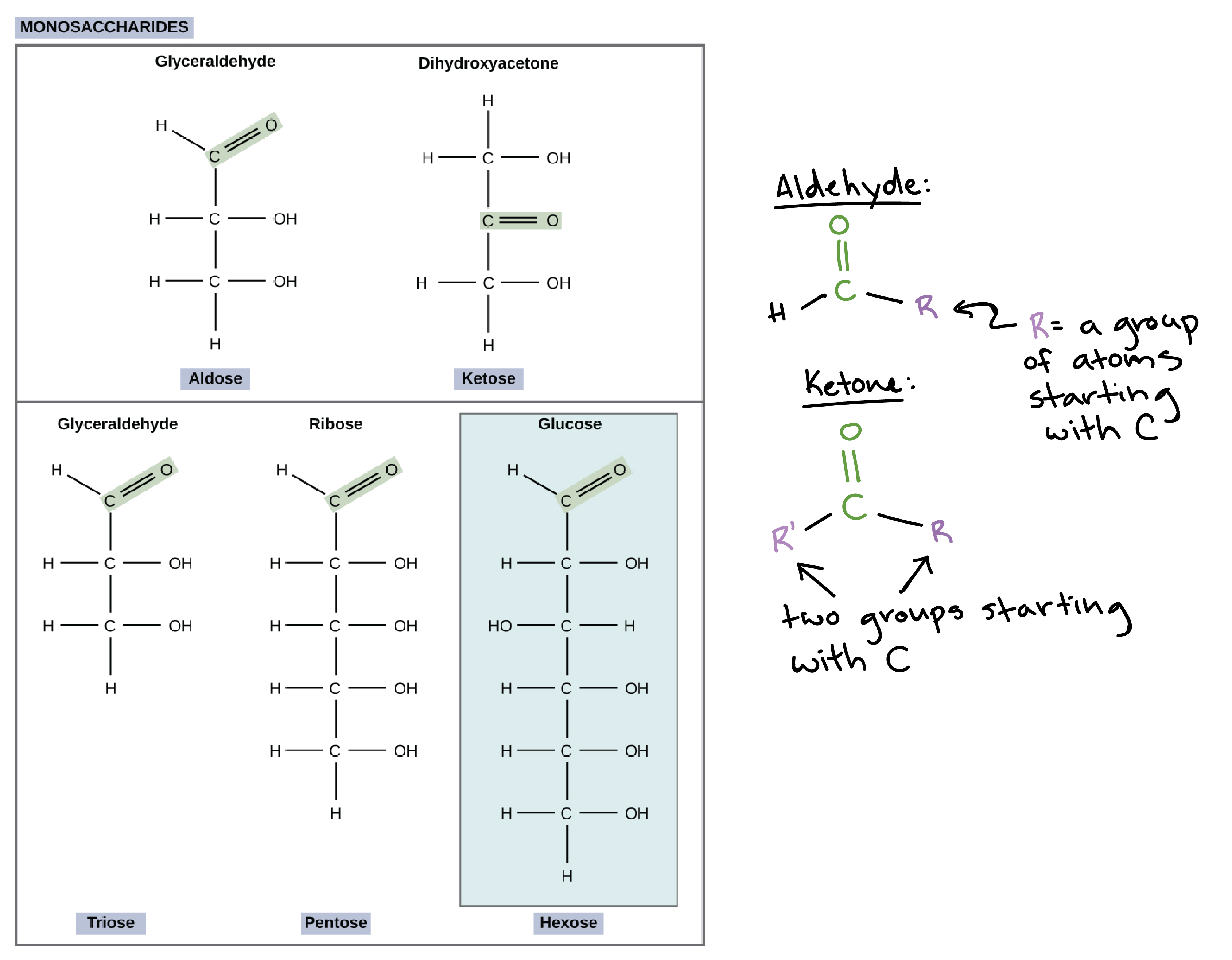
Image modified from OpenStax Biology.
Glucose and its isomers
One important monosaccharide is glucose, a six-carbon sugar with the formula \[\text C_6\text H_{12}\text O_6\]. Other common monosaccharides include galactose (which forms part of lactose, the sugar found in milk) and fructose (found in fruit).
Glucose, galactose, and fructose have the same chemical formula (\[\text C_6\text H_{12}\text O_6\]), but they differ in the organization of their atoms, making them isomers of one another. Fructose is a structural isomer of glucose and galactose, meaning that its atoms are actually bonded together in a different order.
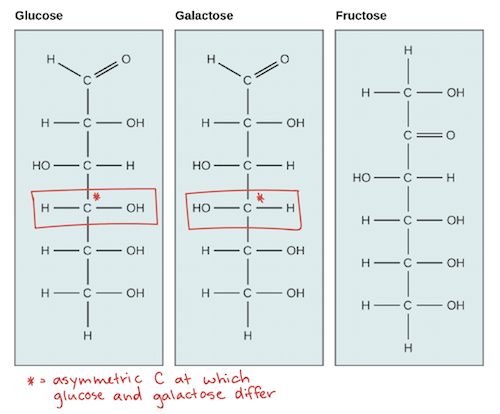
Image modified from OpenStax Biology.
Glucose and galactose are stereoisomers of each other: their atoms are bonded together in the same order, but they have a different 3D organization of atoms around one of their asymmetric carbons. You can see this in the diagram as a switch in the orientation of the hydroxyl (\[\text{OH}\]) group, marked in red. This small difference is enough for enzymes to tell glucose and galactose apart, picking just one of the sugars to take part in chemical reactions\[^1\].
Ring forms of sugars
You may have noticed that the sugars we’ve looked at so far are linear molecules (straight chains). That may seem odd because sugars are often drawn as rings. As it turns out both are correct: many five- and six-carbon sugars can exist either as a linear chain or in one or more ring-shaped forms.
These forms exist in equilibrium with each other, but equilibrium strongly favors the ring forms (particularly in aqueous, or water-based, solution). For instance, in solution, glucose’s main configuration is a six-membered ring. Over 99% of glucose is typically found in this form\[^3\].
Even when glucose is in a six-membered ring, it can occur in two different forms with different properties. During ring formation, the \[\text O\] from the carbonyl, which is converted to a hydroxyl group, will be trapped either “above” the ring (on the same side as the \[\text{CH}_2\text{OH}\] group) or “below” the ring (on the opposite side from this group). When the hydroxyl is down, glucose is said to be in its alpha (α) form, and when it’s up, glucose is said to be in its beta (β) form.
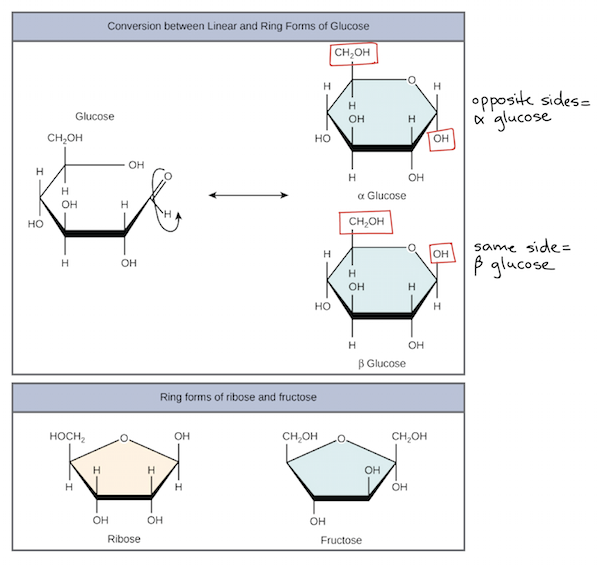
Image modified from OpenStax Biology.
Disaccharides
Disaccharides (di- = “two”) form when two monosaccharides join together via a dehydration reaction, also known as a condensation reaction or dehydration synthesis. In this process, the hydroxyl group of one monosaccharide combines with the hydrogen of another, releasing a molecule of water and forming a covalent bond known as a glycosidic linkage.
For instance, the diagram below shows glucose and fructose monomers combining via a dehydration reaction to form sucrose, a disaccharide we know as table sugar. (The reaction also releases a water molecule, not pictured.)
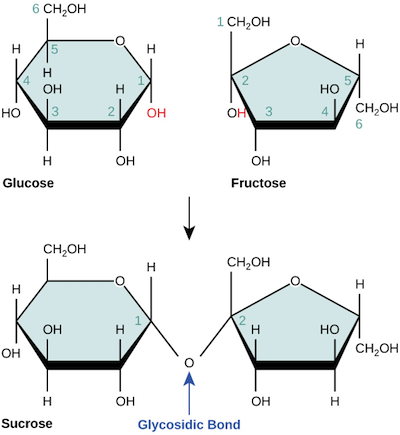
Image credit: OpenStax Biology.
In some cases, it’s important to know which carbons on the two sugar rings are connected by a glycosidic bond. Each carbon atom in a monosaccharide is given a number, starting with the terminal carbon closest to the carbonyl group (when the sugar is in its linear form). This numbering is shown for glucose and fructose, above. In a sucrose molecule, the \[1\] carbon of glucose is connected to the \[2\] carbon of fructose, so this bond is called a \[1\]\[\mbox{-}\]\[2\] glycosidic linkage.
Common disaccharides include lactose, maltose, and sucrose. Lactose is a disaccharide consisting of glucose and galactose and is found naturally in milk. Many people can't digest lactose as adults, resulting in lactose intolerance (which you or your friends may be all too familiar with). Maltose, or malt sugar, is a disaccharide made up of two glucose molecules. The most common disaccharide is sucrose (table sugar), which is made of glucose and fructose.
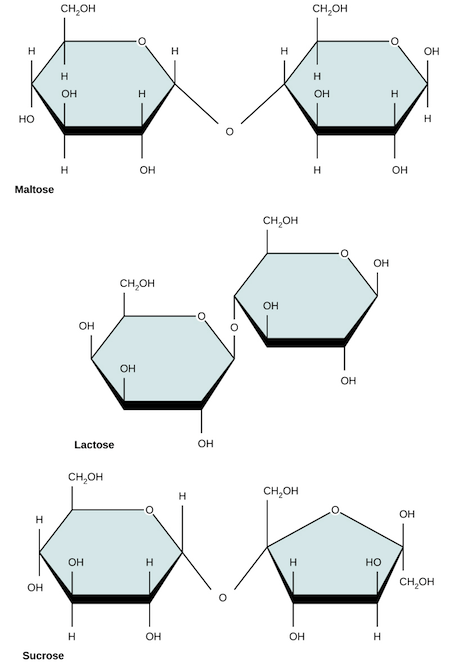
Image credit: OpenStax Biology.
Polysaccharides
A long chain of monosaccharides linked by glycosidic bonds is known as a polysaccharide (poly- = “many”). The chain may be branched or unbranched and may contain different types of monosaccharides. The molecular weight of a polysaccharide can be quite high, reaching \[100,\]\[000\] daltons or more if enough monomers are joined. Starch, glycogen, cellulose, and chitin are some major examples of polysaccharides important in living organisms.
Storage polysaccharides
Starch is the stored form of sugars in plants and is made up of a mixture of two polysaccharides, amylose and amylopectin (both polymers of glucose). Plants are able to synthesize glucose using light energy gathered in photosynthesis, and the excess glucose, beyond the plant’s immediate energy needs, is stored as starch in different plant parts, including roots and seeds. The starch in the seeds provides food for the embryo as it germinates and can also serve as a food source for humans and animals, who will break it down into glucose monomers using digestive enzymes.
In starch, the glucose monomers are in the α form (with the hydroxyl group of carbon \[1\] sticking down below the ring), and they are connected primarily by \[1\]\[\mbox{-}\]\[4\] glycosidic linkages (i.e., linkages in which carbon atoms \[1\] and \[4\] of the two monomers form a glycosidic bond).
Amylose consists entirely of unbranched chains of glucose monomers connected by \[1\]\[\mbox{-}\]\[4\] linkages.
Amylopectin is a branched polysaccharide. Although most of its monomers are connected by \[1\]\[\mbox{-}\]\[4\] linkages, additional \[1\]\[\mbox{-}\]\[6\] linkages occur periodically and result in branch points.
Because of the way the subunits are joined, the glucose chains in amylose and amylopectin typically have a helical structure, as shown in the diagram below.
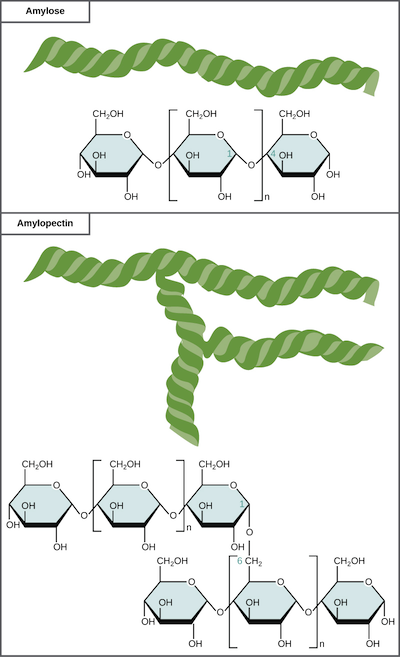
Image credit: OpenStax Biology.
That’s great for plants, but what about us? Glycogen is the storage form of glucose in humans and other vertebrates. Like starch, glycogen is a polymer of glucose monomers, and it is even more highly branched than amylopectin.
Glycogen is usually stored in liver and muscle cells. Whenever blood glucose levels decrease, glycogen is broken down via hydrolysis to release glucose monomers that cells can absorb and use.
Structural polysaccharides
Although energy storage is one important role for polysaccharides, they are also crucial for another purpose: providing structure. Cellulose, for example, is a major component of plant cell walls, which are rigid structures that enclose the cells (and help make lettuce and other veggies crunchy). Wood and paper are mostly made of cellulose, and cellulose itself is made up of unbranched chains of glucose monomers linked by \[1\]\[\mbox{-}\]\[4\] glycosidic bonds.
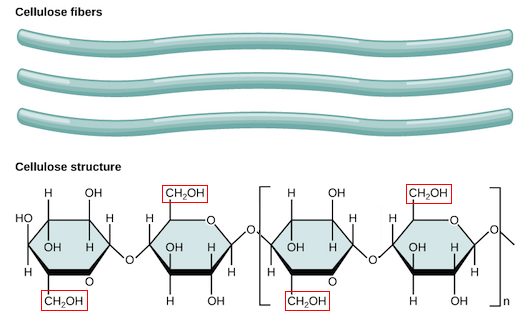
Image modified from OpenStax Biology.
Unlike amylose, cellulose is made of glucose monomers in their β form, and this gives it very different properties. As shown in the figure above, every other glucose monomer in the chain is flipped over in relation to its neighbors, and this results in long, straight, non-helical chains of cellulose. These chains cluster together to form parallel bundles that are held together by hydrogen bonds between hydroxyl groups\[^{4,5}\]. This gives cellulose its rigidity and high tensile strength, which are important to plant cells.
The β glycosidic linkages in cellulose can't be broken by human digestive enzymes, so humans are not able to digest cellulose. (That’s not to say that cellulose isn’t found in our diets, it just passes through us as undigested, insoluble fiber.) However, some herbivores, such as cows, koalas, buffalos, and horses, have specialized microbes that help them process cellulose. These microbes live in the digestive tract and break cellulose down into glucose monomers that can be used by the animal. Wood-chewing termites also break down cellulose with the help of microorganisms that live in their guts.
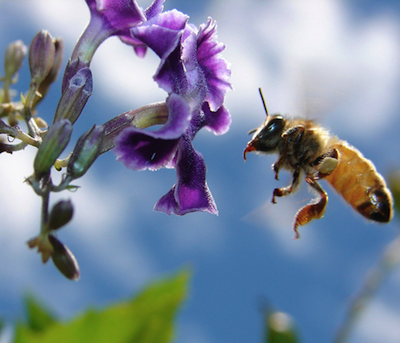
Image credit: Louise Docker.
Cellulose is specific to plants, but polysaccharides also play an important structural role in non-plant species. For instance, arthropods (such as insects and crustaceans) have a hard external skeleton, called the exoskeleton, which protects their softer internal body parts. This exoskeleton is made of the macromolecule chitin, which resembles cellulose but is made out of modified glucose units that bear a nitrogen-containing functional group. Chitin is also a major component of the cell walls of fungi, which are neither animals nor plants but form a kingdom of their own.
